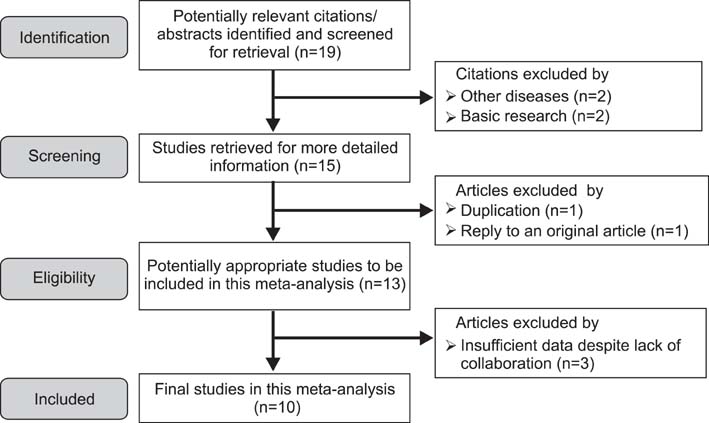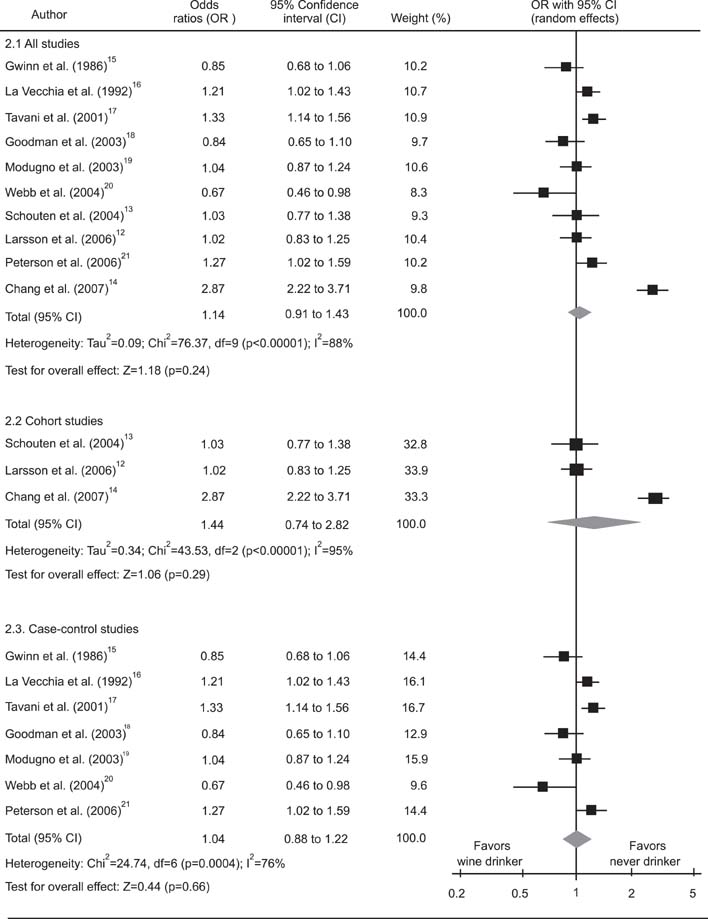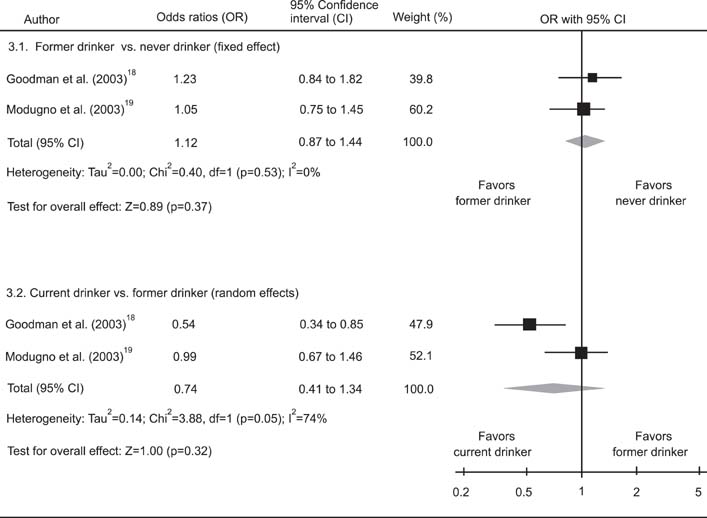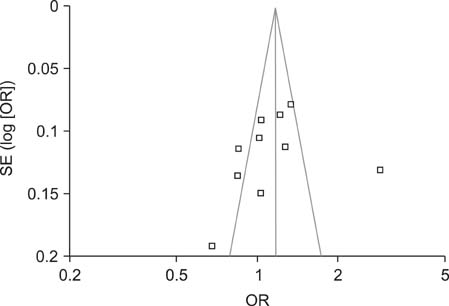J Gynecol Oncol.
2010 Jun;21(2):112-118. 10.3802/jgo.2010.21.2.112.
Wine drinking and epithelial ovarian cancer risk: a meta-analysis
- Affiliations
-
- 1Department of Obstetrics and Gynecology, Seoul National University College of Medicine, Seoul, Korea. kjwksh@snu.ac.kr
- 2Department of Epidemiology, Nutrition and Toxicology Research Institute Maastricht (NUTRIM), Maastricht University, Maastricht, The Netherlands.
- 3Devision of Nutritional Epidemiology, The National Institute of Environmental Medicine, Karolinska Institute, Stockholm, Sweden.
- 4Department of Obstetrics and Gynecology, Seoul National University Bundang Hospital, Seongnam, Korea.
- 5Department of Obstetrics and Gynecology, Ewha Womans University College of Medicine, Seoul, Korea.
- 6Major in Biomodulation, World Class University, Seoul National University, Seoul, Korea.
- KMID: 2009581
- DOI: http://doi.org/10.3802/jgo.2010.21.2.112
Abstract
OBJECTIVE
Wine has been the focus in the prevention of epithelial ovarian cancer (EOC) development because resveratrol abundant in wine has anti-carcinogenic properties. However, epidemiologic results have been heterogenous in the chemopreventive effect of wine on the development of EOC. Thus, we performed a meta-analysis for comparing EOC risk between wine and never drinkers using previous related studies.
METHODS
After extensive search of the literature between January 1986 and December 2008, we analyzed 10 studies (3 cohort and 7 case control studies) with 135,871 women, who included 65,578 of wine and 70,293 of never drinkers.
RESULTS
In all studies, there was no significant difference in EOC risk between wine and never drinkers (odds ratio [OR], 1.13; 95% confidence interval [CI], 0.92 to 1.38; random effects). When we performed re-analysis according to the study design, 3 cohort and 7 case control studies showed that there were also no significant differences in EOC risk between wine and never drinkers, respectively (OR, 1.44 and 1.04; 95% CI, 0.74 and 2.82 and 0.88 to 1.22; random effects). In sub-analyses using 2 case-control studies, EOC risk was not different between former and never drinkers (OR, 1.12; 95% CI, 0.87 to 1.44; fixed effect), and between current and former drinkers (OR, 0.74; 95% CI, 0.41 to 1.34; random effects).
CONCLUSION
Although resveratrol, abundantly found in wine, is a promising naturally occurring compound with chemopreventive properties on EOC in preclinical studies, this meta-analysis suggests the epidemiologic evidence shows no association between wine drinking and EOC risk.
Keyword
MeSH Terms
Figure
Reference
-
1. Sankaranarayanan R, Ferlay J. Worldwide burden of gynaecological cancer: the size of the problem. Best Pract Res Clin Obstet Gynaecol. 2006. 20:207–225.2. Kim K, Ryu SY. Major clinical research advances in gynecologic cancer 2009. J Gynecol Oncol. 2009. 20:203–209.3. Heintz AP, Odicino F, Maisonneuve P, Quinn MA, Benedet JL, Creasman WT, et al. Carcinoma of the ovary: FIGO 6th Annual Report on the Results of Treatment in Gynecological Cancer. Int J Gynaecol Obstet. 2006. 95:Suppl 1. S161–S192.4. Ozols RF, Bundy BN, Greer BE, Fowler JM, Clarke-Pearson D, Burger RA, et al. Phase III trial of carboplatin and paclitaxel compared with cisplatin and paclitaxel in patients with optimally resected stage III ovarian cancer: a Gynecologic Oncology Group study. J Clin Oncol. 2003. 21:3194–3200.5. Blagden S, Gabra H. Promising molecular targets in ovarian cancer. Curr Opin Oncol. 2009. 21:412–419.6. Goswami SK, Das DK. Resveratrol and chemoprevention. Cancer Lett. 2009. 284:1–6.7. Raj MH, Abd Elmageed ZY, Zhou J, Gaur RL, Nguyen L, Azam GA, et al. Synergistic action of dietary phyto-antioxidants on survival and proliferation of ovarian cancer cells. Gynecol Oncol. 2008. 110:432–438.8. Park SY, Jeong KJ, Lee J, Yoon DS, Choi WS, Kim YK, et al. Hypoxia enhances LPA-induced HIF-1alpha and VEGF expression: their inhibition by resveratrol. Cancer Lett. 2007. 258:63–69.9. Kueck A, Opipari AW Jr, Griffith KA, Tan L, Choi M, Huang J, et al. Resveratrol inhibits glucose metabolism in human ovarian cancer cells. Gynecol Oncol. 2007. 107:450–457.10. Tyagi A, Singh RP, Agarwal C, Siriwardana S, Sclafani RA, Agarwal R. Resveratrol causes Cdc2-tyr15 phosphorylation via ATM/ATR-Chk1/2-Cdc25C pathway as a central mechanism for S phase arrest in human ovarian carcinoma Ovcar-3 cells. Carcinogenesis. 2005. 26:1978–1987.11. Opipari AW Jr, Tan L, Boitano AE, Sorenson DR, Aurora A, Liu JR. Resveratrol-induced autophagocytosis in ovarian cancer cells. Cancer Res. 2004. 64:696–703.12. Larsson SC, Giovannucci E, Wolk A. Dietary folate intake and incidence of ovarian cancer: the Swedish Mammography Cohort. J Natl Cancer Inst. 2004. 96:396–402.13. Schouten LJ, Zeegers MP, Goldbohm RA, van den Brandt PA. Alcohol and ovarian cancer risk: results from the Netherlands Cohort Study. Cancer Causes Control. 2004. 15:201–209.14. Chang ET, Canchola AJ, Lee VS, Clarke CA, Purdie DM, Reynolds P, et al. Wine and other alcohol consumption and risk of ovarian cancer in the California Teachers Study cohort. Cancer Causes Control. 2007. 18:91–103.15. Gwinn ML, Webster LA, Lee NC, Layde PM, Rubin GL. Alcohol consumption and ovarian cancer risk. Am J Epidemiol. 1986. 123:759–766.16. La Vecchia C, Negri E, Franceschi S, Parazzini F, Gentile A, Fasoli M. Alcohol and epithelial ovarian cancer. J Clin Epidemiol. 1992. 45:1025–1030.17. Tavani A, Gallus S, Dal Maso L, Franceschi S, Montella M, Conti E, et al. Coffee and alcohol intake and risk of ovarian cancer: an Italian case-control study. Nutr Cancer. 2001. 39:29–34.18. Goodman MT, Tung KH. Alcohol consumption and the risk of borderline and invasive ovarian cancer. Obstet Gynecol. 2003. 101:1221–1228.19. Modugno F, Ness RB, Allen GO. Alcohol consumption and the risk of mucinous and nonmucinous epithelial ovarian cancer. Obstet Gynecol. 2003. 102:1336–1343.20. Webb PM, Purdie DM, Bain CJ, Green AC. Alcohol, wine, and risk of epithelial ovarian cancer. Cancer Epidemiol Biomarkers Prev. 2004. 13:592–599.21. Peterson NB, Trentham-Dietz A, Newcomb PA, Chen Z, Hampton JM, Willett WC, et al. Alcohol consumption and ovarian cancer risk in a population-based case-control study. Int J Cancer. 2006. 119:2423–2427.22. Rosenberg L, Slone D, Shapiro S, Kaufman DW, Helmrich SP, Miettinen OS, et al. Breast cancer and alcoholic-beverage consumption. Lancet. 1982. 1:267–270.23. Celik Y, Temizoz O, Genchellac H, Cakir B, Asil T. A non-alcoholic patient with acute Marchiafava-Bignami disease associated with gynecologic malignancy: paraneoplastic Marchiafava-Bignami disease? Clin Neurol Neurosurg. 2007. 109:505–508.24. Yang SH, Kim JS, Oh TJ, Kim MS, Lee SW, Woo SK, et al. Genome-scale analysis of resveratrol-induced gene expresssion profile in human ovarian cancer cells using a cDNA microarray. Int J Oncol. 2003. 22:741–750.25. Larsson SC, Wolk A. Wine consumption and epithelial ovarian cancer. Cancer Epidemiol Biomarkers Prev. 2004. 13:1823.26. Gallus S, Scotti L, Talamini R, Franceschi S, Dal Maso L, Negri E, et al. Reply to: alcohol consumption and ovarian cancer risk in a population-based case-control study by Peterson et al. Int J Cancer. 2007. 121:2578–2579.27. Genkinger JM, Hunter DJ, Spiegelman D, Anderson KE, Buring JE, Freudenheim JL, et al. Alcohol intake and ovarian cancer risk: a pooled analysis of 10 cohort studies. Br J Cancer. 2006. 94:757–762.28. Tworoger SS, Gertig DM, Gates MA, Hecht JL, Hankinson SE. Caffeine, alcohol, smoking, and the risk of incident epithelial ovarian cancer. Cancer. 2008. 112:1169–1177.29. Chang ET, Lee VS, Canchola AJ, Dalvi TB, Clarke CA, Reynolds P, et al. Dietary patterns and risk of ovarian cancer in the California Teachers Study cohort. Nutr Cancer. 2008. 60:285–291.30. Higgins JP, Thompson SG, Deeks JJ, Altman DG. Measuring inconsistency in meta-analyses. BMJ. 2003. 327:557–560.31. Sterne JA, Egger M. Funnel plots for detecting bias in meta analysis: guidelines on choice of axis. J Clin Epidemiol. 2001. 54:1046–1055.32. Ho SM. Estrogen, progesterone and epithelial ovarian cancer. Reprod Biol Endocrinol. 2003. 1:73.33. Singletary KW, Gapstur SM. Alcohol and breast cancer: review of epidemiologic and experimental evidence and potential mechanisms. JAMA. 2001. 286:2143–2151.34. Cooper GS, Sandler DP, Whelan EA, Smith KR. Association of physical and behavioral characteristics with menstrual cycle patterns in women age 29-31 years. Epidemiology. 1996. 7:624–628.35. Rimando AM, Cuendet M, Desmarchelier C, Mehta RG, Pezzuto JM, Duke SO. Cancer chemopreventive and antioxidant activities of pterostilbene, a naturally occurring analogue of resveratrol. J Agric Food Chem. 2002. 50:3453–3457.36. Wolter F, Clausnitzer A, Akoglu B, Stein J. Piceatannol, a natural analog of resveratrol, inhibits progression through the S phase of the cell cycle in colorectal cancer cell lines. J Nutr. 2002. 132:298–302.37. Potter GA, Patterson LH, Wanogho E, Perry PJ, Butler PC, Ijaz T, et al. The cancer preventative agent resveratrol is converted to the anticancer agent piceatannol by the cytochrome P450 enzyme CYP1B1. Br J Cancer. 2002. 86:774–778.38. Shin NH, Ryu SY, Choi EJ, Kang SH, Chang IM, Min KR, et al. Oxyresveratrol as the potent inhibitor on dopa oxidase activity of mushroom tyrosinase. Biochem Biophys Res Commun. 1998. 243:801–803.39. Wietrzyk J, Grynkiewicz G, Opolski A. Phytoestrogens in cancer prevention and therapy: mechanisms of their biological activity. Anticancer Res. 2005. 25:2357–2366.40. Stopper H, Schmitt E, Kobras K. Genotoxicity of phytoestrogens. Mutat Res. 2005. 574:139–155.
- Full Text Links
- Actions
-
Cited
- CITED
-
- Close
- Share
- Similar articles
-
- Light Alcohol Drinking and Risk of Cancer: A Meta-Analysis of Cohort Studies
- Asbestos Exposure and Ovarian Cancer: A Meta-analysis
- Association of Drinking Patterns and Health Characteristics with Beverage Preference
- Prognostic factors of secondary cytoreductive surgery for patients with recurrent epithelial ovarian cancer
- A Case of Cerebral Metastsis Secondary to Primary Epithelial OvarianCarcinoma : in Complete Responder to Chemotherapy and Surgery





